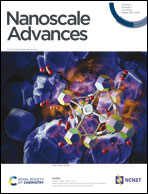Key factors affecting Rayleigh instability of ultrathin 4H hexagonal gold nanoribbons†
Abstract
Rayleigh instability was originally used to describe the phenomenon of a cylindrical fluid jet that transforms into a chain of droplets. Very recently, it has been extended to metallic nanostructures like gold (Au) and silver (Ag) nanowires (NWs), as well as mixed alloy NWs by some thermodynamic processes. To date, the key factors affecting the Rayleigh instability have not been well studied. To clarify this, we systematically investigate the features of Rayleigh instability in ultrathin 4H hexagonal Au nanoribbons (NRBs) under electron beam (E-beam) irradiation. We prove that by decreasing the initial widths of 4H Au NRBs and the E-beam current density, as well as the irradiation time and intensity per unit area, the Rayleigh instability can be effectively restrained. Our work thus sheds light on how to effectively reduce or even eliminate the Rayleigh instability of one dimensional nanomaterials.



 Please wait while we load your content...
Please wait while we load your content...